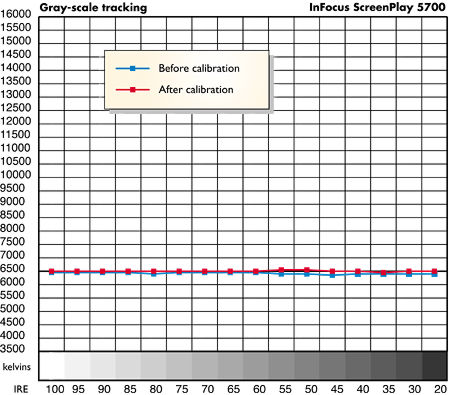InFocus ScreenPlay 5700 DLP Projector Calibration & Comments

Calibration: The InFocus 5700 was measured after Steven Stone had completed his review. All of the measurements and my viewing were done with a Stewart FireHawk screen; SS did his viewing on a Stewart Studiotek 130 screen.
Out of the box, our review sample of the 5700, with its color-temperature control set to 6500 kelvins, produced the results shown in the "Before" curve in the accompanying graph. The 7500K setting measured between 7150K and 7490K from low (30 IRE) to high (100 IRE); the 9300K setting measured from 8300K to 8960K across the same range.
Even out of the box, the 5700's 6500K setting was very accurate. As SS noted, the green was a little hot, though most viewers would likely find the picture at the factory color-temperature setting more than acceptable. Post-calibration (the "After" curve), the result was very close to the optimum D65 (D6500) point across the full range of 30–100 IRE, with both the color temperature and XY coordinates on the CIE color chart very close to the standard—in fact, as good as any DLP projector we have tested. (As is usually the case with front projectors, the 20 IRE level was too low for our Photo Research spectroradiometer to measure.)
The actual color points were close to correct, with red just a little too deep into reddish-orange and green a little yellow-green. But none of this affected the visible color performance, which, after calibration, was excellent, with particularly good flesh tones. The only anomaly I noted was a bit too much glow in some shades of green, though this depended heavily on the program material.
As always, the color temperature was measured and calibrated with the projector's peak white output set just short of clipping and its black level set for a proper PLUGE display. That is, both the top and bottom of the brightness range were set up for as full a range of blacks and whites as the InFocus 5700 was capable of without crushing either. But in doing this, I discovered an interesting anomaly. Before calibration, the maximum peak white I could get from the 5700 was 14.6 footlamberts on my 80-inch-wide screen. After calibration, I could push the projector to 21.5fL before I lost resolution in the brightest whites.
While the 5700's post-calibration peak white output wasn't quite as high as the best we've ever seen—that trophy is held by another InFocus projector, the 7200—it still produced a remarkably bright, punchy image. This involved some sacrifice in contrast; on the FireHawk screen, I measured a full on (a 100 IRE full field) to full off (input blanked) contrast ratio of 796—just slightly better than that of the InFocus 7200. The 5700's average ANSI contrast from a 16-square checkerboard measured 158.
The InFocus 5700 resolved 520 horizontal lines per picture height, as measured with a 1280x720 test pattern on the input. Geometry was good; I saw no barrel or pincushion distortion. With an external crosshatch test pattern, I only saw a slight red fringing, or misconvergence, at the right side of the image from a couple of feet away, and none of the magenta noted by SS. The red fringing was not visible from my seated position 11 feet from the screen.
Comments: I found the InFocus 5700's crisp, detailed picture as appealing as SS did. As with the Runco CL-710 we reviewed in December 2003, it took a careful hand on the sharpness control (here called Luma Detail, which I turned down to "0") to keep the image from looking edgy. The picture was also a little grainier than I've seen from the best 1280x720 HD2 and HD2+ projectors, but this effect was very subtle on my 80-inch-wide screen.
I saw rainbows on the 5700, and while I wish these particular gremlins could be banished from the DLP universe, I was bothered by them less than SS was. The 5700's blacks weren't the best we've seen, but were satisfactory; the Marantz VP-12S2's deepest blacks measured about a fifth as bright as the InFocus's. Fortunately, the human eye doesn't respond linearly; the visible difference was much less pronounced than that wide margin might suggest. The image never looked foggy or blotchy, as it can on LCD projectors attempting to reproduce dark, difficult material. Only on very dim scenes of inherently low contrast did I see a light gray haze overlaid on the image.
After I received the appropriate adapter cables, I was able to try the 5700 with a direct digital connection to an appropriately equipped DVD player—the Marantz DV-8400. The results were superb. While I was not instantly transported to another video plane, it was clear that the DVI link produced a clearer, crisper image. The color reproduction seemed better as well, though the differences here were not as readily apparent. The InFocus' aspect-ratio control was fully operational (at least on the Marantz DVD player), as were the projector's Brightness and Contrast controls—a good thing, since the optimum settings on these controls was considerably different from the settings for component playback. And while there was no sharpness control available from the projector with a DVI source, I did not feel the need for one—again, with this DVD player. (All of the Marantz's onboard video controls were nonfunctional on its DVI output.)
SS was unable to test the InFocus with HD program material, but I did. With its inherent sharpness, good color, and high light output, the 5700 was more than up to the task of fooling all but the most experienced viewer into believing that he or she was watching a high-definition image. It didn't quite provide that extra little thrill that the best HD is capable of when reproduced at its full resolution, but you might nevertheless be pleasantly surprised at how good this projector can look with good program material of all descriptions, both standard and hi-def.—Thomas J. Norton




























































